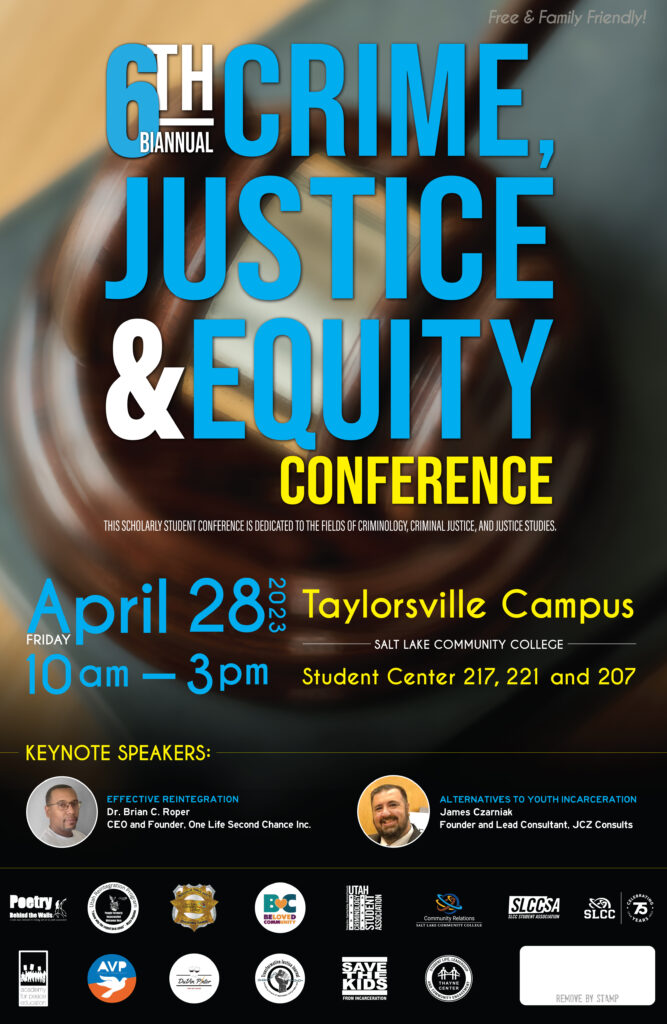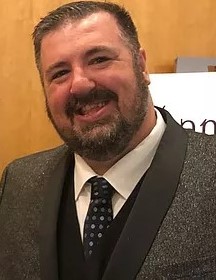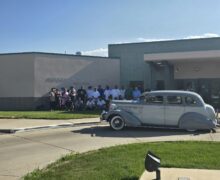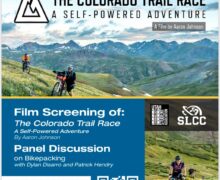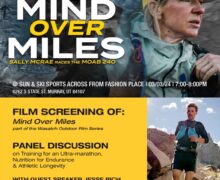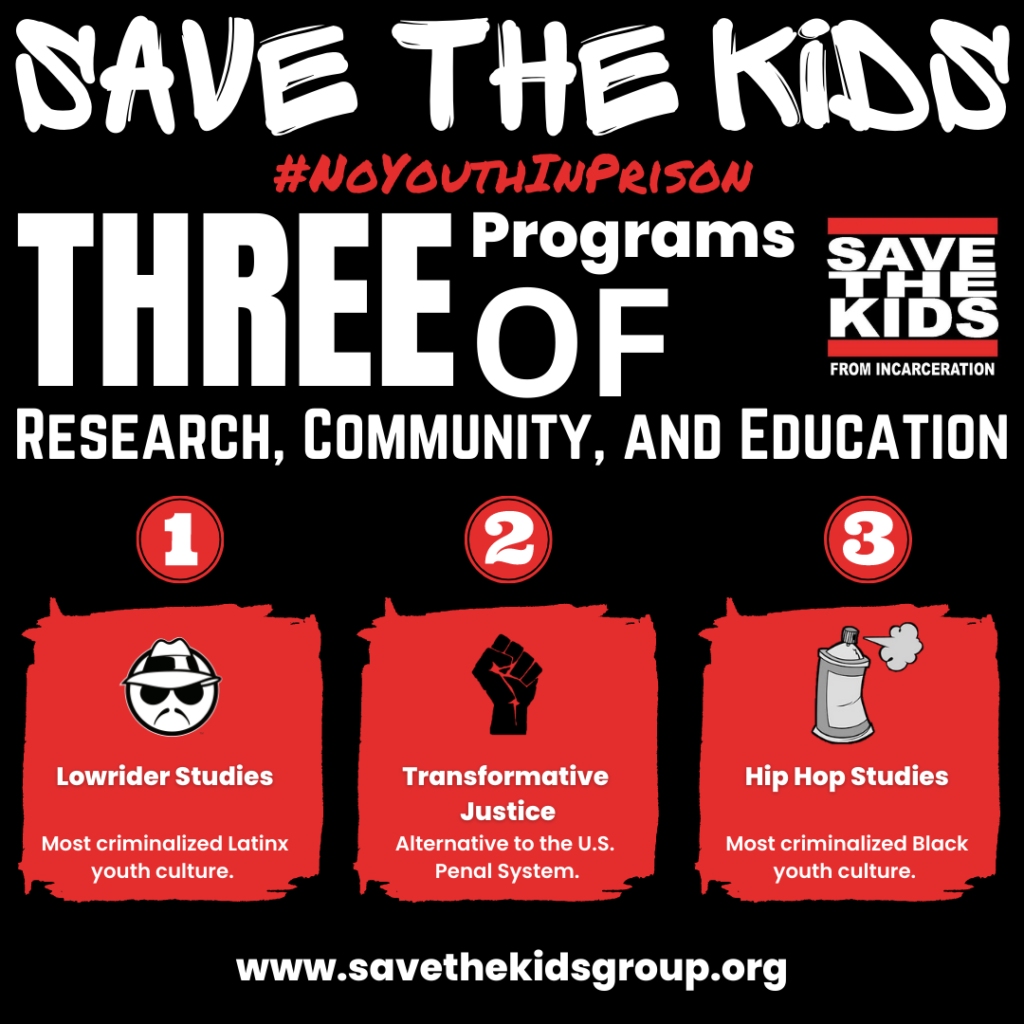6th Biannual Crime, Justice and Equity Conference – April 28, 2023 – Taylorsville Campus 10am to 3pm
6th Biannual Crime, Justice and Equity Conference
Friday, April 28, 2023
4600 South Redwood Road, Salt Lake, UT
Salt Lake Community College, Taylorsville Campus, Student Center, 2nd Floor
Rooms 217, 221, and 207
Free and Open to the Public
SCHEDULE
(Based on USA Mountain Time)
10:00am – 3:00pm
10:00am-10:10am – Welcoming and Introduction – Dr. Anthony J. Nocella II
10:10-11:15am – Session One – Room Student Center 207
Chairperson: David Robles
1. Title: Inside The Criminal Mind: Through A Psychological Lens
Emily Tovar
Biography: Emily Tovar is a student at Salt Lake Community College pursuing her career in
psychology. She will graduate in summer of 2023 with her Associate of Science in
Psychology. She aspires to then transfer to a university to receive her Bachelor’s degree
in order to fulfill her dream of becoming a counseling psychologist. In her studies, Emily
is focusing on abnormal psychology in which she will be able to evaluate and treat a wide
variety of psychological disorders. Her interest in psychology comes from wanting to
advocate the importance of mental health, especially in cultures where it is not given the
appropriate type of treatment and care. After completing her undergraduate studies,
Emily plans on applying for graduate school to further expand her knowledge and fulfill
her career as a counseling psychologist.
Abstract: In this presentation, Emily will explain how the psychology of criminal behavior is a
complex topic that attempts to understand why individuals engage in criminal activities
and behavior. She will explain the variety of factors that can contribute to criminal
behavior, including genetics, early childhood experiences, environmental factors, and
social and cultural influences. She will also share plenty of reasons on why the
importance of understanding the criminal mind is crucial. She will go into depth on how
it can help law enforcement officials to develop effective strategies for preventing and
solving crimes. Additionally, she will also share on why criminal psychology can help
society to better understand and prevent criminal behavior, ultimately promoting public
safety and well-being.
2. Title: How does hybristophilia play a role in society today
Angela Cardenas
Biography: Angela Cardenas is a Salt Lake Community College student graduating with her associate in criminal justice this semester. Angela has faced many challenges growing up in Utah; she developed wanting to understand more about the criminal justice system, how it plays a part in society, and how we can better the system little by little. She hopes, after graduation, to transfer to Virginia Commonwealth University to receive a bachelor’s in criminology and forensic science. She has been a part of the Utah Criminology Student Association for about a year now, which has helped her understand leadership, communication, and what it is like to work as a team and take responsibility. She hopes she can teach others about social justice and how we can make a change within ourselves and society by taking what she learned here at Salt Lake Community College; she hopes to further her education and learn more as she completes her schooling for the next few years.
Abstract: Hybristophilia is an individual who is sexually attracted to a serial killer or an offender that has committed a violent crime; within today’s society, it is the new norm to idolize offenders based on their appearance and not consider what crime they committed. Individuals who have reached out to those incarcerated are known as murder groupies; many known serial killers have fans who are willing to appreciate their work or simply want the attraction and attention of the offender. Many studies have concluded that people who seek the desire to be close to the offender physically, and many do become close where they get what they want. Understanding how it has become so popular amongst adolescents and young adults can help psychologists and criminologists understand what fascination they might have with serial killers and how one is able to better understand that it is a reality to most.
3. Title: The Poor and the Police
Mateo Butterfield
Biography: Mateo Butterfield is a college student at Salt Lake Community College working
towards a criminal justice degree, a subject he is highly passionate about. As an individual from
many marginalized communities, he understands how important it is that everyone is heard and
that everyone should be treated equally. He prides himself on his ability to look at all situations
from every and any angle possible. He tries to address matters with an unbiased and factual
approach. He enjoys working with many people from different backgrounds because it is his core
belief that diversity and education are the keys to an improved society.
Abstract: This presentation is a deep dive into poverty, a phenomenon that is rampant in the
united states, crime, a worldwide occurrence, the link between the two, and how it affects the
relationship between impoverished individuals and law enforcement. It goes over the effects of
each individual aspect and how each subject bounces off of and interacts with one another. Crime
and poverty are NOT directly linked but the correlation between the two is very important to
look into. It’s a subject matter that intertwines like a web, there are many correlations and many
factors that are being tested and constantly changing when it comes to the link between the two.
It’s complex and multifaceted which makes the subject even more interesting to research. Crime,
poverty, and the relationship between the two regarding law enforcement is an important topic to
research so we can get to the root of systemic issues plaguing our society
4. Title: The Impact Immigration Have on Crime Waive in Germany After 2015
Renata de Almeida
Biography: Renata de Almeida, 48 years old, is a physician from Brazil, with 22 years of practice as an Otolaryngologist. Working also as an expert on cases in court justice, Renata knew that the Criminal Justice System in Brazil should do better, for defendants and victims. With a desire to improve her contribution to that System, Renata moved to the USA to increase her knowledge in English and start a new career path studying Criminal Justice at the SLCC and Forensics at another institution. The Criminal Justice System of the USA is the best that we have in the world and the academic environment at the SLCC is inclusive and marked by free speech, said Renata de Almeida.
Abstract: The concern over a positive connection between immigration and crime is widespread. Germany is one of the safest countries in the world. Changes in the level of registered crime can result from changes both in the real crime situation and in reporting behavior. Germany does not yet conduct periodic victim surveys to supplement the statistics. Documented crime and crime rumors fill the newspapers and TV. The empirical analysis of the crime wave is based on different data sources: Bundeskriminalamt (BKA) and Destatis Federal Criminal Police Office, and The Federal Statistical Office, respectively. Overall crime in Germany has fallen to the lowest level since 1992, but there has been an increase in migrant crime in 2016 most of whom are in Germany legally. Leading German criminologists say the best chance of preventing violent crime among migrants is to offer more integration options like language courses, sports, and practical apprenticeships.
5. Title: Risk Factors That Influence Behavioral Outcomes and Increase Sex Crimes
Annia Hungerford
Biography: Annia is an Honors Student and a member of the Phi Theta Kappa Honors Society at Salt Lake Community College. She will be graduating this Spring 2023, with her Associates Degree of Science in Criminal Justice. Annia just started a new job at a law firm as a legal secretary and has applied to several Ivy League Universities for transfer in the fall, including Columbia, Barnard, Cornell, Princeton and Yale, where she plans to continue her studies in a Pre-Law program offered at one of these campuses. Annia enjoys singing, cooking and watching romantic comedies when she’s not studying or drafting up legal documents.
Abstract: Annia’s presentation will discuss the Risk Factors that Influence Behavioral Outcomes and Increase Sex Crimes, while exploring different criminological theories that provide reasoning for why an individual may commit a sex crime. The primary focus of her research was to analyze areas of improvement and provide solutions to combat sexual assault occurrences and decrease societal influences. Annia advocates for anyone that has endured sexual violence and provides a content warning. This subject may be triggering to some individuals in the audience and you are welcome to stay or leave at any point in time.
10:10-11:15am – Session One – Room Student Center 221
Chairperson: Alondra Casaretto Barrera
1. Title: The Effects of Police Brutality Regarding POC
Jesus Loya-Rodriguez
Biography: Jesus Loya-Rodriguez is a student at Salt Lake Community College majoring is psychology. Jesus hopes to achieve in getting a bachelors in psychology at the University of Utah and a masters in psychology, hopefully at University of California, Santa Barbara. Jesus grew up in Salt Lake City, Utah, but has lived in Califonia for five years; he came back for high school and undergraduate school. Jesus enjoys spending his free time building new connections/relationships wih people, indulging in the performing arts, and going to social events: concerts.
Abstract: Police brutality has been around for centuries. As the development technology progressed
throught the past five decades, police brutality cases have inclined in the coverage of the media.
Over the years, hundreds of innocent lives, the lives of people of color, were taken from the
hands of the police. From these repeated behaviors, there has yet to be a demand for justice for
these stolen lives; these lives have left trauma marks on society, we are left with grief. In many
cases, people are led to believe that people of color are the cause of all crime–this is why they’re
targeted. No, this is not the case, systemically, our nation has segregated people of color from
white people. Unfortinatley, even today, police officers who are supposed to protect, do the
complete opposite. They wait for justice is still a waiting response, but perhaps, there are other
ways of addressing this matter. We can see the evolution of systemic racism from the past and
how it has transitioned over to our modern American nation.
2. Title: Why Do We Need Policing?
Kimberly Judith Campos Gill
Biography: Kimberly Judith Campos Gill is a student at Salt Lake Community College majoring in Law Enforcement. Kimberly wants to get her general education requirements at Salt Lake Community College, then transfer to a university and get her bachelors degree. Kimberly lived in Utah all of her life, but she will move out and live in California in the future. Kimberly is a high school student still, but she will graduate this year in class of 2023. Kimberly loves to do art and write some songs in her free-time.
Abstract: Policing can be someone that maintains the law and order by a police force. And in the past
year people have started to not like police because of what they are told to do or what they do in
general. Since what has happened in the USA like with all the protection and shooting people
stop to believe in them and start to fear them. Even though some politicians do a good job as
police they are still hated because of what other police might have done in the past. Seeing all of
this going on just makes me think that police should change, yes, but us the people should
change to cause we know better than to judge other people for what they do.
3. Title: Evolution of Criminological School: A Journey from Lombroso to Modern Day
Daniel Lozano
Biography: Daniel Lozano, a sophomore, is a criminal justice student at Salt Lake Community College. Daniel, a first-generation college student, aspires to become a special agent of the Drug Enforcement Administration (DEA) and intends to transfer to the Utah Valley University to complete his degree in Criminal Justice. Through his academic research and professional career, he hopes to guarantee justice and closure for both victims and communities.
Abstract: The study of criminology in America has undergone significant changes over the years, from the early theories of Cesare Lombroso to the current focus on social and environmental factors. Criminology is a multifaceted field that aims to understand the root causes of criminal behavior and develop effective strategies to prevent and reduce crime. This presentation on criminology in America provides an overview of the key theories, researchers, and trends in the field. It traces the evolution of criminology from Lombroso’s theory of the born criminal to the modern-day approaches that emphasize rehabilitation and restorative justice. By examining the historical development of criminology, this presentation offers valuable insights into how our understanding of crime and punishment has evolved over time.
4. Title: How Media Affects Public Opinion of Crime
Kylee Beacham
Biography: Kylee graduated a year early from high school and started at SLCC in the summer of 2021. She is currently finishing her last two semesters at SLCC with her associate’s in Criminal Justice. She plans to further her education in forensic science and work in the forensic field. Kylee enjoys gardening, painting, reading, writing, and playing video games! She has two dogs, Athena and Dodger, and plans to add a cat once she finishes school.
Abstract: Data and studies can show how news affects the public perception of crime. Cases can show how media coverage can negatively and positively affect trials. This presentation will dive into these things and give a better understanding of the effects of news on crime. It will also provide terms that the public might not hear. Understanding these things can give people information to share with the people around them in hopes some of these negative impacts can be diminished and give people a better sense of how news can exaggerate crime coverage.
10 minutes of Q and A
11:15am – 11:20am – Break
11:20pm – 12:25pm Session Two- Room Student Center 207
Chairperson: Alondra Casaretto Barrera
1. Title: The Media Causing Mental Health Conditions Within The Police Force To Rise In The
United States After The Killing Of George Floyd
Grace Smyth
Biography: Grace Smyth is a 20-year-old Salt Lake Community College student majoring in general studies. Grace hopes to pursue a bachelor’s degree at a to-be-determined university in sports journalism.
She was born in Chicago, Illinois, and grew up in Evanston, IL, until she was four years old
when she moved to Park City, UT. Grace moved to California for a year during second grade, but
after that, her family moved back to Park City permanently. In Grace’s free time, she likes to
spend time with family, watch TV whenever she can, go shopping with friends, watch Chicago
sports teams, and snuggle with her three-year-old chocolate lab, Scout.
Abstract: Police officers are not just protectors of crime; they are human, which means they have mental
health conditions and issues like the general public. The media plays a big part in how they
perceive police officers to the public. After the killing of George Floyd in May 2020, the media
told the story of how law enforcement agencies across the United States would use their power to
overpower an unarmed individual. Due to the media, law enforcement morale was down at the
time because if the police officers did a task wrong or problematic, the media would have a field
day ripping the agency apart. Then if police officers are not able to do their job, it causes them to
isolate themselves from coworkers and family. Isolating themselves can cause various mental
health conditions like depression, anxiety, sleep disorders, etcetera. Even traumatic and stressful
situations in the field can cause officers to have post-traumatic stress disorder. Mental health
conditions can then affect how police officers perform their everyday jobs.
2. Title: The Problem of Human Trafficking In The United States
Ashley Tiftikchyan
Biography: Ashley Tiftikchyan is a student at Salt Lake Community College. She is majoring in
Biology. Ashley is hoping to pursue a degree at University of California, Santa Barbara for
zoology. She was born in Salt Lake City and lives with her family in Murray. Ashley has two
younger brothers and her parents, she also has three dogs. Ashley in her free time likes to make
ceramic art, go on walks, hangout with friends, go to concerts, and enjoys listening to music any
chance she gets
Abstract: Human trafficking is the exploitation for commercial sex or forced labor through force,
fraud, or coercion is known as human trafficking. Regardless of whether force, fraud, or coercion
was used, any person under the age of 18 who engages in commercial sex is considered a victim
of human trafficking. Human trafficking is the 21st-century’s fastest-growing criminal industry,
estimated to be worth $150 billion and second only to drugs in terms of organized crime.
California, Florida, and New York are three states that are particularly susceptible to human
trafficking because of things like: proximity to international borders, a lot of ports and airports, a
lot of immigrants, and big economies with industries that attract forced labor are all factors.
3. Title: The Problem of the U.S. Prison System and the Racial Divide that it Fuels
Joey F. Kush
Biography: Joey F. Kush is a student at Salt Lake Community College majoring in business. Joey is hoping to pursue a bachelor’s degree in business from the University of Utah. He is from Sacramento California, and moved to Utah 2 years ago due to his Dad’s job office being here in Utah. Joey is currently doing school full-time and is also working a part-time job. In his freetime he likes to play drums, read novels and manga, thrift, and play videogames.
Abstract: The U.S. prison system is a very flawed system at best. The U.S. Prison system currently houses
nearly 2 million inmates. 1 out of 5 incarcerated people in the world are incarcerated in the United States. Over the years there has been a disparity in the races of the inmates. There is racism ingrained in the U.S. and its history, leading to a large number of African Americans being imprisoned during the war on drugs and presidents Nixon and Reagan’s campaigns. Even from Bill Clinton and his time in office, the three strikes and mandatory minimum laws lead to even more BIPOC being incarcerated. Inside the U.S. prisons there is deep rooted racism and segregation and because prisons and colleges are microcosms of society, it reflects a bigger problem in our nation as a whole. Although there are no mandatory racial segregation laws in the U.S., many inmates practice voluntary racial segregation. From the racial segregation in the
prisons, many gangs have formed, one of which, MS13, was started in California prisons. These
gangs have spread from prisons onto the streets where they grow larger, this is a problem.
4. Title: The Problem of Unfair Care Quality in the United States Healthcare System
Haley Bryant
Biography: Haley Bryant is a student at Salt Lake Comminuty College majoring in Pre-Medical Health Sciences. Haley is hoping to pursue a bachelor’s degree at Weber State University in Respiratory Therapy. She is from Sandy, Utah. Haley in her free time likes to study biology, watch pro-gamers on YouTube, try new TV dramas, shop online, and spend time with her younger brother Nathan.
Abstract: Millions of people worldwide need healthcare. Doctors, nurses, therapists, among other
healthcare staff, are expected to provide the care necessary to give their patients the relief and
comfort they need. Over the past 100 years, the problem of unfair care quality in the United
States healthcare system has been at an all-time high. With healthcare workers refusing to treat
patients, discrimination continues to be a major issue within the United States. Causes and
effects of discrimination in healthcare are discussed below.
10 minutes of Q and A
11:20pm – 12:25pm Session Two – Room Student Center 221
Chairperson: Anthony J. Nocella II
1. Title: The effects of Gentrification on BIPOC in the United States
Gabriela Barela
Biography: Gabriella Barela is a 19 year old from the United States. She is a student at Salt Lake
Community College majoring in Psychology. Gabriella is transferring to the University of Utah,
planning to receive her bachelors and later plans to move out of state to receive her masters and
or PhD. For the long term, she plans to get a job in Occupational therapy or working as a mental
health therapist for adolescents. Aside from going to school full time, she likes to be with her
family and friends and likes to spend time by herself to catch up on listening to music, and sleep.
Abstract: People’s resistance and challenge to displacement has been happening in American history for many years within the systemic racism category. The damages of gentrification results in peopleof color disproportionately impacted by location, leading to health risks and mental health problems caused by industrial polluters targeting low-income minority communities. These industrial toxic facilities emit lead, arsenic, and other contaminants into the water, food, and lung of these communities with some not having access to running water. Regulations and policies, and corporate choruses made so that BIPOC communities are targeted with unwanted hazardous waste and pollutants, by the lack of power, the implementation of policies that allow these harmful projects to be placed within these communities. These structures and policies are set up by local state practices, leading to the access to have these toxins of waste and pollutants nearby these communities households with low income salary. Including the Native American reservations across America and Canada. These reservations were made by settlers to push Native Americans off new lands and leave these communities to starve, no access to regular
resources they once had, and homelessness. This example is one of the earliest gentrification
examples here in the United States of America.
2. Title: Trauma from Immigration and Youth Incarceration by ICE
Guillermo Sanchez Juarez
Biography: Guillermo Sanchez Juarez is a student at Salt Lake Community College. Guillermo hopes to
eventually get a bachelors degree at the University of Utah. He grew in in Michoacan, Mexico.
He and his moved to the U.S. when he was 11 years old. They lived in Las Vegas for a year
before moving to Salt Lake City. In his free time, he likes to cook, he likes to hike, he likes to
research his genealogy, and he also likes to spend time with friends and family.
Abstract: he way the government deals with immigration has been a controversial topic. People being
incarcerated at the border while trying to cross is always a main topic. Parents and kids being
incarcerated in horrible conditions while their situation is being processed is always talked about.
Families already have trauma from having to escape or leave their country. They also face more
stress when trying to cross the border, things like being separated at the border does not help
their mental health. Kids being separated from their parents and being put into a tight space with
no livable conditions is not a way to deal with immigration. Kids will be taken with the parents
wherever they go, being separated will leave a traumatic scar in them. Immigrants will always
face obstacles in a country they were not born in. They will face trauma while crossing the
border, they will also face obstacles related to healthcare, language barriers, and education. Child
welfare agencies are not often prepared to help people with these kinds of backgrounds. The
struggles met while in search for a better life should be less traumatic for families. Immigration
will always be present, with or without any help from the government. Some ways that we can
help family is to have better prepared staff to help immigrant families.
3. Title: Criminals Right to a Speedy Trial
Dylan Campbell
Biography: Dylan Campbell is a student at Salt Lake Community College majoring in computer engineering.
After Salt Lake Community College, Dylan hopes to transfer to the University of Utah to
continue their education towards getting a bachelor’s degree in computer engineering, after
which they hope to get a job with Intel or AMD. Dylan grew up in Salt Lake City, Utah and has
lived there their whole life. In their free time they like to work on cars, play video games, read,
write amateur code, build computers and solve software and hardware problems.
Abstract: This essay discusses the sixth amendment right in the United States Constitution, specifically the
right to a speedy trial. The essay will explain what the right to a speedy trial is, the Speedy Trial
Act of 1974 which outlines the allowable time a defendant can wait before receiving a trial. It
goes over how and why our sixth amendment right to a speedy trial is violated and the
devastating consequences of violating our sixth amendment right to a speedy trial has on a
defendant and the criminal trial. It discusses how prolonged court dates have been used as a tool
of prejudice and how it can be coincidental. And it outlines underlying issues with the Supreme
Court and District Court and what needs to be done.
4. White Ignorance
Jerold Darrius Uchechi Acord
Biography: Jerold Darrius Uchechi Acord is a student at Salt Lake Community College, currently
majoring in computer science. He is working towards becoming a software engineer, and wants
to help manage and support the back end of large tech companies, preferably those involving
artificial intelligence. He was born in Utah and currently lives in Draper, where he attends school
and is working towards an associates degree. In his free time he enjoys skating and hiking.
Abstract: This article seeks to describe and analyze the effect of white ignorance to both social and
systematic instances of racism on the black/african american population in the US. While there
have been many strides in the past that have put people of all colors in more equal positions
within the US, it is false to say that people of color are at the same position and stature as white
people in our society. Unfortunately, this is the view of many white Americans in the US. It is
evident that for people of color, it is necessary to be aware of instances of racism, because it can
not only lead to unequal opportunities and accessibility to resources, but in some cases it can be
life threatening. This is not true for the dominant group, as they are much less likely to be the
target of racism or discrimination within this country. This analysis will explain the origins of
this thought pattern, the mental reasoning behind it, the effects it has on people of color, and the
methods in which this attitude may be mitigated or reversed entirely.
10 minutes of Q and A
12:25pm to 12:40pm – Room 221
Chairperson: Angela Cardenas
Lunch – Pizza and there will be Vegan Options and Soda and Juice (For Free)
12:40pm to 12:50 – Awards – Room Student Center 221
Recognizing the Outstanding Criminal Justice Awards for Spring 2023
Chairpeople – Stephanie Hoffman, David Robles, and Cecile Delozier
Outstanding Academic Achievement Awards
Skylar Christensen
Talmage Healey
Max Kovacs
Outstanding Health and Wellbeing Achievement Award
Alondra Barrera
Outstanding Rise Up Achievement Award
Annia Hungerford
Outstanding Inclusivity and Equity Achievement Award
Mateo Butterfield
Outstanding Service Achievement Award
Liz Howell
EFFECTIVE REINTEGRATION
Keynote 12:50pm to 1:15pm
Q and A: 1:15pm to 1:30pm
Student Center, 221
Chairperson: David Robles
Keynote Speaker: Dr. Brian C. Roper
Dr. Brian C. Roper is CEO/Founder of One Life Second Chance Inc. In this role, Dr. Roper created the S.E.E.S. Freedom Program which aids former offenders with the reintegration process. In addition, he serves as a board member with the Center of Conflict Resolution of Kansas City. Dr. Roper is dedicated to guiding, educating, and inspiring individuals reentering into society to become productive and successful members of the community.
Dr. Roper is currently involved with several social justice initiatives in the Kansas City metropolitan area. He has gained expertise in the criminal justice system specifically reentry and recidivism through extensive research and his own lived experiences. Dr. Roper has spoken at a variety of criminal justice symposiums, correctional centers, and churches. His latest research study addressed the effectiveness of the Missouri Reentry Process.
Dr. Roper earned his B.S. in Criminal Justice from University of Central Missouri, M.S. in Criminal Justice from Colorado Technical University, Master of Philosophy in Criminal Justice from Walden University, and PhD in Criminal Justice specializing in Public Management and Leadership. Dr. Roper was awarded the “Speaker of Year” by the Gavel Club in 2009 and the “Leadership Excellence Award” by Walden University in 2022.
ALTERNATIVES TO YOUTH INCARCERATION
Keynote 1:30pm to 1:55pm
Q and A: 1:55pm to 2:10pm
Room Student Center, 221
Chairperson: David Robles
Keynote Speaker: James Czarniak
James Czarniak is the founder and lead consultant of JCZ Consults. James spent twenty years working in the non-profit and government sectors, most recently as the Deputy Commissioner for the Onondaga County Department of Children and Family Services, specifically focused on Child Welfare Services. As Deputy Commissioner, the County focused heavily on decreasing the use of congregate care and increasing the use of kinship care, becoming a leader in the state. James previously served as the Director of Juvenile Justice for Onondaga County in Central New York for 8 years and led a reform initiative that saw a reduction in detention and out of home placement by almost 50% while increasing local investment in services and alternatives that reduced recidivism and youth re-entry into the system. James has also worked for the Boys & Girls Clubs of Syracuse in both Syracuse, NY and in Washington DC and worked in Congress for the Ways and Means Committee. James graduated from Washington College with a degree in Political Science and is a member of the Annie E. Casey Applied Leadership Network, he has completed certificates in Data Sharing and Multi-System Integration from Georgetown University Public Policy Institute and is trained in Results Based Accountability, Results Based Leadership, and Results Based Facilitation. James is involved in many local committees and sits on several boards that focus on supporting children and families in the community.
2:10pm – 2:15pm – Break
2:15pm -3:20pm – Session Three – Room Student Center 221
Chairperson: Stephanie Hoffman
Title: Another One Bites the Dust: An Assessment of Fingerprint Powder, Wavelength, and Filter Visualization Combinations of Prints on Multi-Colored and/or Densely Patterned Substrates
Devynn Mayfield and Daniel Lozano
Biographies: Devynn Mayfield, a freshman, and Daniel Lozano, a sophomore, are both criminal justice majors at Salt Lake Community College. Devynn aspires to become a Crime Scene Specialist and intends to transfer to Texas A&M University to complete her B.S. in Forensic and Investigative Sciences. Daniel, a first-generation college student, aspires to become a Drug Enforcment Administration (DEA) Special Agent and intends to transfer to Utah Valley University to complete his B.S. in Criminal Justice. Through their academic research and professional careers, they hope to ensure justice and closure for both victims and communities.
Abstract: “…Examiners continue to be frustrated by a number of ‘difficult’ substrates…” as “multi-colored and densely patterned backgrounds…can prevent the successful imaging of fingerprints (Foster+Freeman, 2022).” Noting a dearth of research on ultraviolet (UV) and infrared (IR) imaging of fluorescent fingerprint powders, said researchers imaged (12) commercially available fingerprint powders developed on (10) different multi-colored and patterned substrates under UV and IR wavelengths and filters to determine what combinations work best. The authors assessed various filters (from Kolari, Life Pixel, Peca, and Tiffen) in conjunction with Dedolight’s KMULTI4 Forensic Kit of (4) Multi-Spectrum Ledzilla Focusing Lights. When surfaces are exposed to different wavelengths of light and filter combinations one or more of the following reactions can occur: absorption (darkens), reflection (lightens), transmission (disappears), and/or fluorescence (glows). The authors’ findings will either verify and/or disprove commonly held beliefs about what wavelength, filter, and powder combinations will ease fingerprint comparisons on such complicated surfaces.
Title: Fingerprint Clarifications in a Flash: Green Screens, Not Just for Superheroes
Ashley Rojas and Holly Turner
Biographies: Ashley Rojas and Holly Turner are both criminal justice majors in their sophomore year at Salt Lake Community College (SLCC). Both aspire to become Detectives, the first with a focus on Sex Crimes, the latter on Homicides. Holly intends to enroll in SLCC’s Law Enforcement Academy (LEA) in order to become a Certified Peace Officer. Ashley intends to transfer to the University of Utah to complete her B.S. in Nursing. Through their academic research and professional careers, they hope to ensure troubled youth and victims are heard and treated with dignity and fairness to ensure justice, closure, and a second chance. They also hope that their representation as minorities being females, a single young mother, and a Latina will encourage victims, suspects, and/or witnesses to speak out.
Abstract: After viewing this presentation, the audience will understand the capabilities and limitations of Green Screen (Version 2023.2), a smartphone application by Do Ink as it pertains to the photographic clarifications of fingerprints. This presentation will inform the forensic community by showcasing the app’s ability to aid in the post processing of fingerprints on multi-colored and/or densely patterned backgrounds. While this application was not originally developed for post-processing forensic purposes, it does have utility for such and can more effectively remove distracting colors (through addition or subtraction) and/or “…obstructive patterns…, which can routinely make the difference between an indecipherable area of obstructed ridge detail and an identifiable fingerprint (The Approach Developing Enhancement Strategies for Images Intended for Analysis, 2018).” This application has been proven to be more accurate and efficient in clarifying the images through its ability to simultaneously control the chroma key and opacity settings than Adobe Photoshop. A workflow will be presented to demonstrate the potential benefits of a more simplified process for the forensic community.

